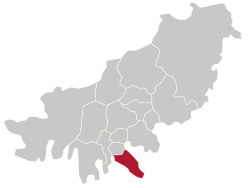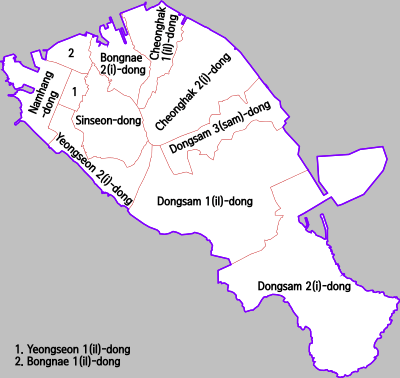Yeongdo District
Yeongdo District is a gu in Busan, South Korea. The gu itself is limited to Yeong-do (Yeong Island) located on the south edge of central Busan. It attained the status of gu in 1957.
Yeongdo 영도구 | |
|---|---|
| Korean transcription(s) | |
| • Hanja | 影島區 |
| • Revised Romanization | Yeongdo-gu |
| • McCune-Reischauer | Yǒngdo-ku |
 | |
 | |
 | |
| Country | South Korea |
| Region | Yeongnam |
| Provincial level | Busan |
| Administrative divisions | 11 administrative dong |
| Area | |
| • Total | 14.15 km2 (5.46 sq mi) |
| Population (2017[1]) | |
| • Total | 124,026 |
| • Density | 8,800/km2 (23,000/sq mi) |
| • Dialect | Gyeongsang |
| Website | Yeongdo District Office |
The Korea Maritime and Ocean University and the National Maritime Museum of Korea are located in Yeongdo-gu.
Origin of the Name "Yeongdo"
The former name of Yeong-do (Yeong Island) was Jeolyeong-do (Jeolyeong Island).
Mythologically, horses that could run a thousand miles, so-called "Chollima", lived on this island. Because the horses living on this island could run so fast that their shadows could not follow them, this island was called, "Jeolyeong-do".
After the South Korea government arranged their administrative divisions' names, the name of the island was changed to, "Yeongdo-gu. [2]
Administrative divisions
Yeongdo-gu is divided into 22 legal dong, which altogether comprise 11 administrative dong, as follows:

| Legal dong | Administrative dong |
|---|---|
| Namhang-dong 1-ga | Namhang-dong |
| Namhang-dong 2-ga | |
| Namhang-dong 3-ga | |
| Daegyo-dong 1-ga | |
| Daegyo-dong 2-ga | |
| Daepyeong-dong 1-ga | |
| Daepyeong-dong 2-ga | |
| Daepyeong-dong 3-ga | |
| Yeongseon-dong 1-ga | Yeongseon 1-dong |
| Yeongseon-dong 2-ga | |
| Yeongseon-dong 3-ga | Yeongseon 2-dong |
| Yeongseon-song 4-ga | |
| Sinseon-dong 1-ga | Sinseon-dong |
| Sinseon-dong 2-ga | |
| Sinseon-dong 3-ga | |
| Bongnae-dong 1-ga | Bongnae 1-dong |
| Bongnae-dong 2-ga | |
| Bongnae-dong 3-ga | |
| Bongnae-dong 4-ga | Bongnae 2-dong |
| Bongnae-dong 5-ga | |
| Cheonghak-dong | Cheonghak 1-dong |
| Cheonghak 2-dong | |
| Dongsam-dong | Dongsam 1-dong |
| Dongsam 2-dong | |
| Dongsam 3-dong |
Cityscape


 Nighttime in Yeongdo
Nighttime in Yeongdo West Side of Yeongdo
West Side of Yeongdo
See also
- Geography of South Korea
- Subdivisions of South Korea
External links
| Wikimedia Commons has media related to Yeongdo-gu, Busan. |
- Yeongdo-gu website (in English)
